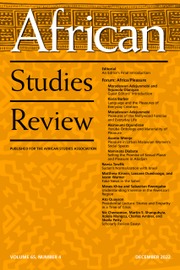Anthologies of African theatre and performance conventionally assemble a range of dramatic texts from across the expansive geography known as “Africa,” however broadly or narrowly defined. Simon Gikandi and R.N. Sandberg further extend the purview of such an anthology by offering “an introduction to the dramas of Africa and the African diaspora” (1). As the inaugural entry in Methuen Drama’s “Global Theatre Anthologies” series, this collection provides readers with access to overlooked and often out-of-reach playscripts ranging from an Ancient Egyptian religious pageant (The Triumph of Horus) to the first published African drama (Tekle Hawariat’s Fabula: Yawreoch Commedia) to a Guyanese dramatization of postcolonial racial fragmentation (Michael Gilkes’ Couvade). Gikandi and Sandberg’s anthology deserves praise for its ambitious scope and for its recuperation of such a wide array of otherwise obscure performance texts. Indeed, in addition to the three texts already mentioned, the volume also includes a Yoruba masque, Duro Ladipo’s Yoruba folk opera Oba Kò So (The King Did Not Hang), and Elvania Namukwaya Zirimu’s Ugandan drama When the Hunchback Made Rain, none of which were previously readily available. These more esoteric performance texts are accompanied by four canonical postcolonial dramas that are widely accessible in other anthologies: Wole Soyinka’s Death and the King’s Horseman, Ama Ata Aidoo’s Anowa, Athol Fugard, John Kani, and Winston Ntshona’s Sizwe Bansi Is Dead, and Derek Walcott’s Dream on Monkey Mountain.
Readers seeking to expand their familiarity with African and Caribbean drama beyond the canon will find in this anthology several interesting and provocative plays. Zirimu’s When the Hunchback Made Rain is a particularly vibrant addition, offering a comical satire of the postcolonial disjunctures between peasant life and political (and divine) authority. Ladipo’s Oba Kò So stages a dramatic and compelling plot of Șàngó’s divine scheming to retain his power. Meanwhile, Hawariat’s allusive and ambiguous Fabula: Yawreoch Commedia and the Yoruba Masque of the Boa-Constrictor provide dramaturgically complex cultural performances that productively expand the scope of “African plays” into new genres and forms.
However, any volume that attempts to encompass “ancient, indigenous and modern plays from Africa and the diaspora” is bound to encounter the insurmountable challenge of adequately surveying millennia of theatre and performance across such an expansive geography. The anthology strains to be both comprehensive and novel in its curation, and it stretches to a breaking point due to the decision to attempt coverage of both Africa and its diaspora. As a result, the anthology is uneven, comprising eight (primarily West) African performance texts and only two Caribbean dramas. The anthology also offers a temporally remote conceptualization of “modern” African and Caribbean drama—the most recent play included in the anthology was originally performed in 1975. More importantly, its privileging of Anglophone drama unfortunately led to the exclusion of the work of Francophone dramatists such as Aimé Césaire, Koffi Kwahulé, and Werewere Liking. Why would a series of “Global Theatre Anthologies” not allocate space for a standalone volume on Africa and another on the Caribbean, each of which might encompass a broader array of theatre and performance from their respective geographies?
Given the anthology’s sprawling ambit, it would benefit readers to have detailed maps of the cultural geographies of the volume’s ten plays. However, the volume’s exceedingly brief, five-page general introduction and its similarly concise play introductions fail to adequately provide such historical, political, and aesthetic contextualization. Notably, the anthology lacks visual supplements despite the importance of costuming and masks to the plays’ dramaturgies. The reference lists provided for each play are also strikingly short, as they typically include only one or two suggestions for further reading. The lack of editorial input is particularly apparent in the case of the references provided for The Triumph of Horus, which directs readers to seek out the out-of-print version of the performance text that the anthology would ideally have rendered redundant. This editorial approach recurs throughout the anthology, with the emphasis on brevity trumping the need for rich contextualization that might make the performance texts more accessible to novice readers.
The critical issues hampering this anthology likely do not originate with the editors—who evince care and creativity in their curation of the volume’s plays—but rather with the publisher, Methuen Drama. The choice to cast an expansive historical and geographic net does not make sense as an intellectual project, but it does have a clear business logic. Similarly, the paucity of editorial commentary throughout the volume perhaps stems from the press’s desire to limit the anthology’s word count. In any event, the press does not demonstrate the same care with the volume’s plays as the editors: the anthology is marred by inconsistent copy editing, ranging from different formatting for notes across different plays and frequent, occasionally jarring errors in spelling and typography. Such mistakes are inauspicious signs for the “Global Theatre Anthologies” series, and Methuen Drama would do well to remedy them in future entries.
Despite these issues, this anthology makes for a welcome addition to curricula addressing African and Caribbean theatre. As an introductory volume, it draws together a rich assemblage of complex and vibrant performance texts from Africa and its diaspora, translating African performance forms to the page. It will make for a generative resource for courses on African literature, dramatic or otherwise.


